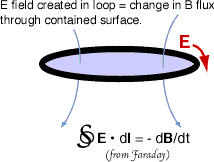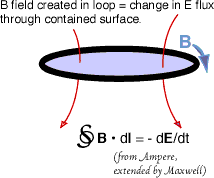 Michael Faraday envisioned lines of force originating of positive electric charges and terminating on negative charges. The uniform field of electric force is shown that is created by two parallel conducting (metal) plates charged oppositely.
Michael Faraday envisioned lines of force originating of positive electric charges and terminating on negative charges. The uniform field of electric force is shown that is created by two parallel conducting (metal) plates charged oppositely.
 Charges moving through a conductor (driven by an Electric field between charges) generates a magnetic field circular about the conductor.
Charges moving through a conductor (driven by an Electric field between charges) generates a magnetic field circular about the conductor.
 If the conductor is a circular loop, magnetic field flux is produced inside the loop.
If the conductor is a circular loop, magnetic field flux is produced inside the loop.
If a charge moves relative to a magnetic field, it (and the field) experience a force F = qv x B where the velocity and magnetic field strength B are vectors, and the force is the cross product at perpendicular to the plane generated by v and B.
James Clerk Maxwell compiled the various rules for electricity and magnetism. Electric lines of force originate on charges. Gauss´s Law connects the electric charge to the net number of electric lines of force of leaving a closed volume (in this case a box at left). In mathematical terms, the strength of the electric field, E, through each small surface area, ds, summed over the entire two dimensional area depends on the charge, q.
Magnetic lines of force have no ends. So a similar Gauss´s Law finds the the strength of the magnetic field, B, through each small surface area, ds, summed over the entire two dimensional area (in this case the box on right) is zero because every entering magnetic line of force must also leave the volume.


Faraday had found that the changing number of magnetic lines of force creates an electric field (and thus a current in a conducting loop). Maxwell expressed this mathematically by stating the the CHANGE in the amount of magnetic flux with time (dB/dt) equals the Electric field in each section of loop (E•dl) summed around the entire one dimension loop (on left)
A similar principle from Ampere states that the CHANGE in the amount of Electric flux with time (dE/dt) equals the Magnetic field in each section of loop (B•dl) summed around the entire one dimension loop (on right).


So a changing electric field creates a changing magnetic field; and a changing magnetic field creates a changing electric field. Therefore an oscillating electric charge would create a wave spreading out in space that alternates between oscillating magnetic and oscillating electric fields. The ratio of the strengths of the electric and magnetic constants are in the units of speed squared. Maxwell presumed this could only be the speed of this spreading wave. When Maxwell calculated this speed, its value of 3 x 108 meter/second matched the known speed of light. Maxwell wrote This velocity is so nearly that of light, that it seems we have strong reason to conclude that light itself (including radiant heat, and other radiations, if any) is an electromagnetic disturbance in the form of waves propagated though the electromagnetic field according to electromagnetic laws.
Heinrich Hertz demonstrated in 1886 that Maxwell was indeed correct. An oscillating current in one loop of wire would transmit a wave across some distance and drive a current around a nearby loop of wire.
21 year old Italian Guglielmo Marconi read about Hertz's experiments found in 1895 that by increasing the power of the transmitter and stretching a wire high in the air for an antenna, and improving on the method of detection, the distance of transmission could be greatly increased. By 1900 he had communicated with a detector 200 miles away.
In 1906 F. A. Fressenden used a continuous oscillating current to broadcast music from Brant Rock, Massachusetts, to U.S. naval ships nearby.
Meanwhile in 1887 Albert Michelson and Edward Morley attempted to measure the speed at which the Earth travels through the æther that carries the electromagnetic oscillations. But the failed to detect any motion of the earth.
Several attempts at explaining the null result were replaced by a brilliant explanation by 26 year old Albert Einstein in 1905 who suggested a special law of relativity.